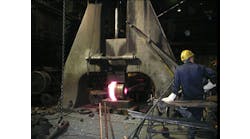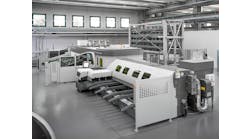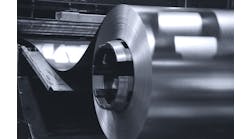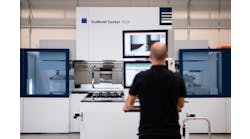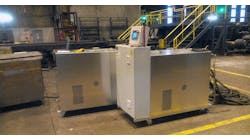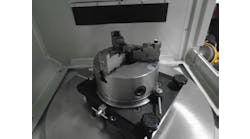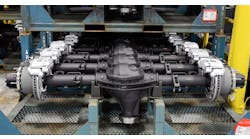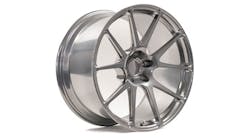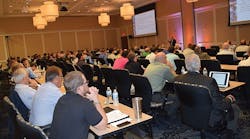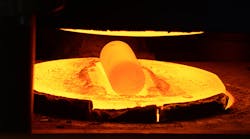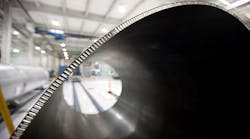“An up-to-date and comprehensive plan to address technology needs is essential to the Forging Industry Educational and Research Foundation (FIERF),” according to Paul Dennis, FIERF President “As the needs of the industry evolve, we must continue to reflect those changes in the Forging Technology Roadmap and communicate those needs to our customers, suppliers and research partners.”
The Forging Foundation (FIERF) and Forging Industry Association began the process of developing a vision for the future of the industry in 1996, and the first Forging Technology Roadmap was presented in 1998. Since then, periodic reviews have broadened the roadmap from a solely technical and research document to embrace a broader view of the industry’s direction, and to include issues of education, process efficiency, and public policy, in addition to traditional and emerging technologies.
In that spirit, recently the FIERF Board of Trustees spent several months reaching out to stakeholders, and reviewing and updating the industry’s self-described needs, aiming to:
• Improve market positioning
• Develop current and future workforce
• Advocate public policy agendas
• Establish industry guidelines and best practices
• Enhance material options and usage
• Reduce energy usage per unit of manufacture
• Advance forging technology
“From the beginning of the vision and road mapping process in the 1990s, both the Association (FIA) and the Foundation (FIERF) have used the roadmap to identify and pursue programs and activities to benefit our stakeholders,” noted Roy Hardy, FIA President. “Examples include increasing advocacy activities in Washington, expanding contact with students at the university and high school levels through the FIERF Magnet School program, partnering with ASM to sponsor Materials Camps for Teachers™ and developing and deploying new training courses and seminars to meet industry’s need for on-going training of incumbent employees.”
Future workforce development, enhanced materials, reduced energy and the advancement of forging technology are at the core of the Foundation’s mission to support the forging industry through technology development and education.
The technology objective is to develop, support and fund technology and research to benefit the North American forging industry. Education efforts include encouraging forging curriculum in universities, and engaging students to consider careers in the forging industry through scholarships, process information and experiential learning opportunities.
In September, the Forging Industry Technical Conference in Columbus, OH, offered an important example of the intersection of the technology and education objectives of the Foundation. Presentations included a report of six FIERF-funded projects as well as nationally and internationally known industry thought leaders and researchers. Sessions addressed the growing fields of metal additive manufacturing and light weighting – both areas of emerging technologies noted in the 2016 Roadmap.
The New Cycle
And so, a new cycle begins. Presentations at the Technical Conference closed the loop in the process of funding technology to engage researchers, students and industry in development and then transferring that knowledge to forging producers.
Earlier this year the FIERF Board approved funding five new technology projects:
1. Forging of Magnesium Alloys for Automotive Applications
Professor May Wells, University of Waterloo, Dept. of Mechanical and Mechatronics Engineering, and two graduate students, are engaged in the project that seeks “to design, build and validate an automotive, fatigue-critical component made of forged magnesium.” Ford Motor Co. is the industry partner to their research.
“Magnesium (alloys are) the next materials for lighter, more efficient cars,” according to Wells.
2. High-Strength, High-Toughness Microalloyed Steel Forgings Produced Using Relaxed Forging Conditions and No Heat Treatment
Professor Anthony DeArdo, University of Pittsburgh, Dept. of Mechanical Engineering & Materials Science, and a graduate student, are seeking a “new composition and process route for making high-strength, high-toughness forging with minimum die wear, limited distortion and no heat treatment.”
In this research, university’s industry representative is Dr. Graham McIntosh, chief technology officer at Universal Stainless. The project’s industry partner is Meadville Forge.
Prof. DeArdo explained the project’s outcome would be, “a new forging steel capable of satisfying a wide range of applications will be developed in this program. Forgings with strengths ranging from 60 KSi (420 MPa) to 120 KSi (840 MPa) will result from one forged piece cooled in different ways without the need of final heat treatment.
“The high toughness of these steels will result from intense grain refinement caused by the hypo-stoichiometric TiN particles that will pin the prior austenite grain boundaries,” according to DeArdo. “The cooling paths (to be) used will generate ferrite-pearlite, bainitic, or martensitic microstructures, thereby leading to different strength levels. Carburizing or high sulfur levels will be available when induction hardening or machinability are required.”
“This material and process will provide an opportunity to improve the strength of our forgings and reduce cost. These two elements are very important to us in regard to being competitive in the U.S.,” added Carl McLean of Meadville Forge, where forging trials will take place.
3. Development of a Manufacturing Process for High-Power-Density Hollow Shafts
Professor Gracious Ngaile, North Carolina State University Dept. of Mechanical and Aerospace Engineering, with two student researchers (one graduate, one undergraduate), will work to develop a cost-effective manufacturing process for high-power-density hollow shafts. The project’s industry partner is Mid-West Forge.
“The powertrain for cars and trucks carries a significant percentage of the total weight of a vehicle. For example, the powertrain in Classes 1–3 accounts for 36% of the total weight, whereas in Class 8 the power train accounts for 48%,” explained Prof. Ngaile. “The majority of power transmission systems used in the automotive, aerospace, maritime, and other industries employ solid shafts. Utilization of high-power-density hollow shafts will drastically reduce the weight of the power transmission system thus improving fuel efficiency.
Competing Parameters
“To facilitate rapid adaptation of the developed technology in the forging industry, the research team has conceived a forging scheme for manufacturing hollow shafts that utilizes conventional forging machines and associated technologies.”
“Mid-West Forge is excited to be a part of this collaborative and innovative team. We look forward to contributing to the development of process advances leading to the next generation of driveline components. Mid-West Forge is honored to help prepare future engineers entering the forging industry and mutually benefiting from the shared growth of this knowledge base,” added Derek Stake, Mid-West Forge.
John Walters, vice president at Scientific Forming Technologies Corp., put the project in context. “High-power-density components in critical service applications are virtually always produced from forgings. The toughness and fatigue properties of forgings are ideal for these applications, due to the microstructure that cannot be replicated by other processes.
“In the automotive world, the requirements also include production in high-volume, near-net-shape geometry, robust processes and very aggressive cost control,” Walters continued. “The process development, with many competing parameters, is critical to a successful outcome. These part developments are far more complex than simply changing tooling geometry and hoping for the best. FIERF is funding this project, and FIA members from the Technical Committee and FIERF Board will collaborate with NC State during this work.”
4. Using Post-Sintering Forging to Improve Mechanical Properties of Additive Manufactured Parts: Experimental Characterization
Professor Timothy Cyders, Ohio University Dept. of Mechanical Engineering, with a graduate student will study and quantify the improvements in mechanical properties that forging can impart on customized, additive manufactured components as a post-process. The project’s industry representative is Suzanne Tkach, Tkach Consulting LLC.
“With the rise of additive manufacturing technology, it is important to understand how the toughness and fatigue properties of additive manufactured components compare to that of traditionally forged products. Additionally, we would like to explore further how additive manufacturing technology can be augmented by or integrated with traditional forging processes, to meet the needs of our customers” Tkach explained.
According to Dr. Cyders, “Initial results indicate that plastic deformation imparts significant densification and potentially significant improvement in mechanical properties of additive manufactured preforms. As such, this could eventually lead to forging and similar processes being critical post-process treatments in the creation of the highest performance lightweight/optimized additive manufactured parts.”
5. Hydraulic Press Update & Experimental Investigation of Die Surface Friction
Professors Joseph Domblesky and Tony Bowman, Marquette University, Dept. of Mechanical Engineering, with a graduate student assistant, seek to upgrade an existing laboratory press to improve its capability to perform experimental-based forging studies in Phase I of this project.
In Phase II, they aim to formulate a friction model that incorporates temperature and surface roughness conditions that could be implemented in finite element-based forging simulation software. The industry partner is Walker Forge.
“While friction has long been a concern in hot forging operations, the relationship between friction and the die surface is still not well understood,” Prof. Domblesky elaborated. “While it is recognized that dies should be neither too “smooth” or too “rough,” there is little information as to what an optimum surface roughness is, and what value should be specified when machining a forging die. As few guidelines exist, it is not uncommon for die prints to specify that a ‘smooth’ surface be machined on a die with the result that the actual surface roughness is often left up to the die room.
“Furthermore,” he continued, “the effect of surface lay is recognized to be influential but here too, little information appears to be available. This study is intended to begin a systematic experimental investigation to understand how die roughness and lay influence metal flow and if these parameters can be used in die design.”
Industry participation as the voice of the customer is critical to the success of Foundation-funded research, according to Walker Forge president Rick Recktenwald, who interacts on a regular basis with the University. “The Marquette Engineering Team seeks out industry input, prior to project/experiment definition and development, to ensure relevancy to today’s forging process opportunities,” he noted.
Selection Criteria
The process of selecting projects for funding by the FIERF Board of Trustees begins with the Roadmap. Each project is measured by the extent to which the work being proposed and student involvement in the project matches with the industry’s stated needs, as outlined in the Roadmap.
The projects selected are required to have industry participation in the form of representatives and industry partners to serve as the voice of the customer, and to keep research industry relevant. Grant submissions are reviewed and mentored by the FIA Technical Committee that will ultimately submit a recommendation to the FIERF Trustees for funding based on technical and educational merits. Then, trustees make grant awards based on available funding.
Funding for all grants, scholarships, and activities are made possible through the generosity of the Foundation’s corporate and individual donors. The amount of contributions coming into the Foundation is what the Trustees have to budget for the year’s programming needs.
The administrative support of the Forging Industry Association is important to the Foundation because it allows all tax-deductible contributions go straight to projects and students, not overhead costs. See https://www.forging.org/forging-foundation-fierf/fierf-honor-roll-of-contributors for a list of Corporate Platinum, Gold, Silver and Bronze Anvil Society Members and individual contributors to the Foundation.
Karen Lewis is the Executive Director of the Forging Industry Educational and Research Foundation. Contact her at [email protected].
For more information on the Forging Technology Roadmap, or to make a contribution or designate gifts, please contact the Forging Industry Educational & Research Foundation at tel. 216.781.6260, [email protected]); or see http://bit.ly/2fMkzzV

